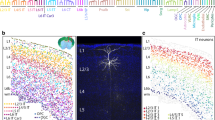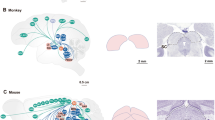Summary
InGryllus campestris the visual field of the compound eye (average spatial angle 207°) and the binocular overlap of both compound eyes (46% of the total visual field) were determined with the aid of the deep pseudopupil, in order to have a reference system for the location of the receptive field of medulla neurons.
A detailed quantitative analysis of two types of medulla neurons has been carried out with small test light spots given above a certain background illumination.
One type of unit gave sustained off-responses. This type had a large receptive field with an off-center in the medio-posterior part of the eye and an incomplete antagonistic surround. The use of disks moved through the receptive field confirmed the antagonistic center-surround organization.
The second type of unit was a sustained on-neuron. Several uniform and large receptive fields without a surround and with different locations in the eye were found. Moving targets of either contrast suppressed the firing of this cell type. In this respect, the cell's response resembled that of a certain type of ganglion cells in the vertebrate retina (uniformity detectors).
Similar content being viewed by others
References
Arnett, D.W.: Spatial and temporal integration properties of units in first optic ganglion of dipterans. J. Neurophysiol.35, 429–444 (1972)
Barlow, H.B., Fitzhugh, R., Kuffler, S.W.: Change of organization in the receptive fields of the cat's retina during dark adaptation. J. Physiol.137, 338–354 (1957)
Barlow, H.B., Levick, W.R., Westheimer, G.: Computer plotted receptive fields. Science154, 920 (1966)
Beersma, D.G.M., Stavenga, D.G., Kuiper, J.W.: Retinal lattice, visual field and binocularities in flies. J. Comp. Physiol.119, 207–220 (1977)
Burghause, F.M.H.R.: Vergleichende Untersuchungen über die unterschiedlich organisierten Doppelaugen vonBaëtis (Ephemeroptera),Gyrinus (Coleoptera) and mehrerer Grillenarten (Orthoptera). PhD-thesis, Berlin (1978)
Burkhardt, D., Darnhofer-Demar, B., Fischer, K.: Zum binokularen Entfernungssehen der Insekten. 1. Die Struktur des Sehraums von Synsekten. J. Comp. Physiol.87, 165–188 (1973)
Butler, R.: The anatomy of the compound eye ofPeriplaneta americana L. 1. General features. J. Comp. Physiol.83, 223–238 (1973)
DeVoe, R.D., Ockleford, E.M.: Intracellular responses from cells of the medulla of the flyCalliphora erythrocephala. Biol. Cybern.23, 13–24 (1976)
Franceschini, N., Kirschfeld, K.: Les phénomènes de pseudopupille dans l'oeil composé deDrosophila. Kybernetik9, 159–182 (1971)
Frantsevich, P.M., Mokrushov, P.: Jittery movement fibres (J.M.F.) in dragonfly nymphs: stimulus-surround interaction. J. Comp. Physiol.120, 203–214 (1977)
Honegger, H.-W.: Sustained and transient responding units in the medulla of the cricketGryllus campestris. J. Comp. Physiol.125, 259–266 (1978)
Honegger, H.-W., Schürmann, F.W.: Cobalt sulphide staining of optic fibres in the brain of the cricket,Gryllus campestris. Cell Tissue Res.159, 213–225 (1975)
Kien, J.: Motion detection in locusts and grasshoppers. In: The compound eye and vision of insects. Horridge, G.A. (ed.), pp. 409–422. Oxford: Clarendon Press 1974
Kien, J., Menzel, R.: Chromatic properties of interneurons in the optic lobes of the bee. I. Broad band neurons. J. Comp. Physiol.113, 17–34 (1977a)
Kien, J., Menzel, R.: Chromatic properties of interneurons in the optic lobes of the bee. II. Narow band and colour opponent neurons. J. Comp. Physiol.113, 35–53 (1977b)
Kuffler, S.W.: Discharge patterns and functional organization of mammalian retina. J. Neurophysiol.16, 37–68 (1953)
Levick, W.R.: Receptive fields and trigger features of ganglion cells in the visual streak of the rabbit's retina. J. Physiol.188, 285–307 (1967)
Levick, W.R.: Another tungsten microelectrode. Med. Biol. Lug.10, 510–515 (1972)
Mimura, K.: Movement discrimination by the visual system of flies. Z. Vergl. Physiol.73, 105–138 (1971)
Mimura, K.: Analysis of visual information in lamina neurones of the fly. J. Comp. Physiol.88, 335–372 (1974)
O'Shea, M., Rowell, C.H.F.: Protection from habituation by lateral inhibition. Nature254, 53–55 (1975)
Rodieck, R.W.: Receptive fields in the cat retina: a new type. Science157, 90–92 (1967)
Rowell, C.H.F.: The orthopteran descending movement detector (DMD) neurones: A characterisation and review. Z. Vergl. Physiol.73, 167–194 (1971)
Rowell, C.H.F., O'Shea, M., Williams, J.L.D.: The neuronal basis of a sensory analyser, the acridid movement detector system. IV. The preference for small field stimuli. J. Exp. Biol.68, 157–185 (1977)
Seidl, R., Kaiser, W.: Visual field size, binocular domain and the ommatidial array of the compound eyes in honeybee. J. Comp. Physiol. (in press)
Author information
Authors and Affiliations
Additional information
This project was supported by the Deutsche Forschungsgemeinschaft, grant Ho 463/10 and Ma 374/8
It is a pleasure to thank Mrs. R. Müller for excellent technical assistance, Mr. D. Kastenholz for help during the experiments, Drs. J. Kien, H. Markl and H. Wässle for useful discussions and criticism, Drs. E. Florey and L. Fischer (SFB 138) for the use of the Nicolet MED 80 computer and Mr. P. Hörmann and Mr. W. Kühnel of the finemechanics workshop of the University of Konstanz for construction of equipment. I am also grateful to Dr. K. Kirschfeld for introducing me to the use of the deep pseudopupil for visual field measurements.
Rights and permissions
About this article
Cite this article
Honegger, H.W. Receptive fields of sustained medulla neurons in crickets. J. Comp. Physiol. 136, 191–201 (1980). https://doi.org/10.1007/BF00657533
Accepted:
Issue Date:
DOI: https://doi.org/10.1007/BF00657533




